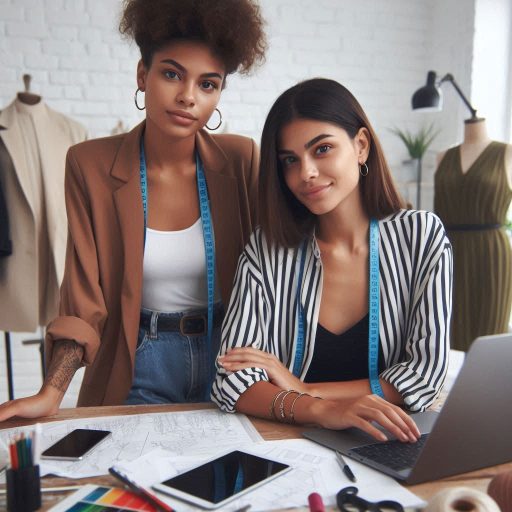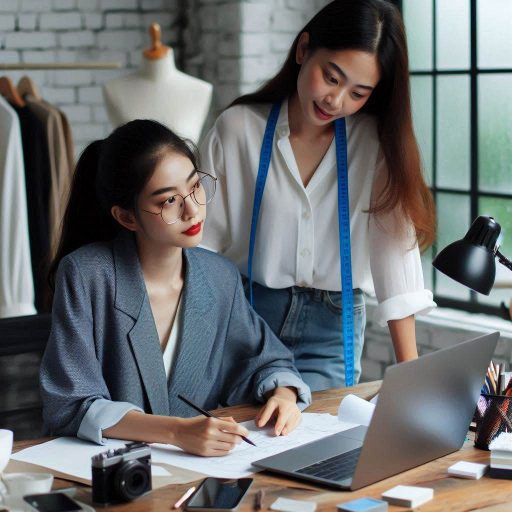Introduction
A fashion designer is a visionary who transforms creative ideas into wearable art.
They play a pivotal role in the fashion industry by conceptualizing, designing, and bringing to life clothing and accessories that define trends and reflect personal and cultural expressions.
Their work involves understanding market demands, innovating with fabrics and designs, and ensuring that each piece meets aesthetic and functional standards.
Fashion designers are crucial in setting industry trends and pushing the boundaries of style.
Their creations influence not only what people wear but also how fashion evolves over time.
By blending creativity with technical skills, designers drive the industry forward and inspire global fashion movements.
Understanding a day in the life of a fashion designer reveals the dedication and hard work behind their creative process.
From sketching initial ideas to overseeing production, their day is a blend of artistic vision and practical challenges.
Showcasing the complexities and excitement of their role in the fashion world.
Morning Routine
Wake Up Early
A typical day for a fashion designer starts early.
The alarm rings before dawn, signaling the beginning of a productive day.
Rising early sets a positive tone and creates a head start.
Fashion designers often wake up at 5 or 6 a.m., ready to embrace the day’s challenges.
Early mornings provide quiet time for reflection and planning before the hustle begins.
Exercise or Meditation to Start the Day
After waking up, the designer engages in exercise or meditation.
Physical activity boosts energy levels and sharpens focus.
Whether it’s a run, yoga session, or gym workout, exercise invigorates the body.
Meditation, on the other hand, calms the mind and prepares it for creative thinking.
Both practices contribute to a balanced and productive start to the day.
Breakfast and Coffee to Fuel the Day Ahead
Post-exercise or meditation, the designer heads to the kitchen for breakfast.
A healthy meal is crucial for sustaining energy levels.
Designers often opt for a mix of fruits, yogurt, and whole grains.
Breakfast is paired with a strong cup of coffee, which helps jump-start the brain.
Coffee fuels creativity and alertness, setting the stage for a productive day.
With breakfast finished and energy levels high, the designer starts planning the day ahead.
Mornings are ideal for setting goals and organizing tasks.
Reviewing the schedule, focusing on meetings, and checking emails are essential.
Early organization helps manage the day’s workflow efficiently.
By mid-morning, the designer transitions from personal routines to professional tasks.
This could involve sketching new designs or reviewing fabric samples.
The morning hours are productive, perfect for tackling complex design challenges.
An organized workspace supports efficient design processes.
In summary, a fashion designer’s morning routine is crucial for setting a productive tone.
Waking up early, incorporating exercise or meditation, and enjoying a nutritious breakfast with coffee are key elements.
This routine fuels both the body and mind, preparing the designer for a day of creativity and professional challenges.
Design Process
Meeting with Team to Discuss Current Projects
The design process begins with a team meeting.
Designers, pattern makers, and other team members gather to discuss ongoing projects.
This meeting often starts with a review of current progress and challenges.
Team members share updates, address issues, and align on project goals.
Effective communication ensures everyone is on the same page and helps streamline the workflow.
These discussions set the tone for the day’s work and establish priorities.
Sketching and Creating New Designs
After the team meeting, the designer dives into sketching and creating new designs.
This phase is crucial for translating ideas into visual concepts.
The designer experiments with different styles, fabrics, and colors.
Sketches evolve into detailed designs, exploring various possibilities for each piece.
This creative process allows for innovation and experimentation.
The designer might use traditional drawing techniques or digital tools to refine their concepts.
Collaborating with Colleagues on Ideas and Concepts
Collaboration is a key aspect of the design process.
The designer frequently works with colleagues to brainstorm and refine ideas.
This collaboration may involve working with other designers, textile experts, or marketing professionals.
Discussions focus on enhancing design concepts and integrating feedback.
Sharing ideas and insights helps improve the overall quality and feasibility of the designs.
Team collaboration fosters a creative environment and ensures that the final product aligns with both aesthetic and functional goals.
In summary, the design process for a fashion designer involves a blend of teamwork, creativity, and collaboration.
Starting with team meetings to discuss projects, moving through sketching and creating new designs.
Working closely with colleagues on ideas, each step is essential for developing innovative fashion pieces.
This structured yet flexible approach ensures that designs are both creative and practical, ready to make an impact in the fashion world.
Read: Top Skills Needed for Art Educators and Instructors
Fabric Selection
Visiting Fabric Suppliers
Fabric selection begins with visiting fabric suppliers.
The designer heads to showrooms or fabric markets to explore new materials.
These visits involve examining a variety of fabrics, from luxurious silks to durable cottons.
Suppliers showcase their latest collections, offering a wide range of options.
The designer carefully feels the texture, checks the quality, and notes the colors available.
This hands-on approach ensures the materials meet the design vision and project requirements.
Choosing the Right Materials for Upcoming Collections
Once back from fabric visits, the designer selects materials for upcoming collections.
This process involves matching fabrics with design concepts and seasonal trends.
The designer considers factors such as drape, durability, and comfort.
Each fabric is evaluated for its suitability in achieving the desired look and functionality.
Choosing the right materials is crucial for translating design ideas into wearable fashion.
The selected fabrics will play a significant role in the overall aesthetic and quality of the collection.
Discussing Color Palettes and Textures with Team
The next step involves discussing color palettes and textures with the design team.
The designer meets with colleagues to review fabric choices and explore color options.
This collaborative discussion helps refine the collection’s visual direction.
The team considers how different textures and colors work together and align with the design concept.
They also address any practical considerations, such as seasonal appropriateness and production feasibility.
This dialogue ensures that the final fabric choices enhance the overall design and meet the collection’s goals.
In summary, fabric selection is a critical part of the fashion design process.
Visiting fabric suppliers, choosing the right materials, and discussing color palettes and textures with the team are essential steps.
Each phase ensures that the fabrics chosen will support the creative vision and contribute to a successful fashion collection.
Read: Collaborating with Other Creative Roles
Fittings and Adjustments
Meeting with Models for Fittings
Fittings and adjustments begin with meeting models for garment fittings.
The designer schedules sessions where models try on the latest designs.
During these fittings, the designer assesses how each garment fits and moves.
This process allows the designer to see the garment in action and make necessary observations.
Meeting with models is crucial for understanding how designs translate from sketches to real life.
It provides insights into the fit, drape, and overall appearance of each piece.
Making Adjustments to Garments
Following the fittings, the designer makes adjustments to the garments.
This involves altering patterns and refining the fit based on model feedback.
The designer might adjust hems, seams, or dart placements to improve the garment’s silhouette and comfort.
These modifications ensure that each piece aligns with the designer’s vision and meets quality standards.
Making precise adjustments is key to achieving the desired look and ensuring the garment performs well on different body types.
Ensuring Perfect Fit and Quality Control
The final step in the fittings and adjustments process is ensuring perfect fit and quality control.
The designer reviews each garment to confirm it meets all design specifications and quality standards.
This includes checking stitching, fabric alignment, and overall finish.
Quality control ensures that each piece is not only visually appealing but also well-constructed and durable.
The designer’s attention to detail during this stage guarantees that the garments are ready for presentation or production.
In summary, the fittings and adjustments phase is essential in the fashion design process.
Meeting with models for fittings, making necessary adjustments, and ensuring a perfect fit and quality control are key steps.
This meticulous process ensures that each garment is both stylish and functional, ready to make a statement in the fashion world.
Read: Historic Costume Design Inspirations
Client Meetings
Meeting with Potential and Existing Clients
Client meetings are a critical part of a fashion designer’s day.
The designer schedules appointments with both potential and existing clients.
These meetings provide an opportunity to build relationships and understand client needs.
For potential clients, the designer introduces their portfolio and discusses design capabilities.
For existing clients, the focus is on reviewing ongoing projects and future needs.
Meeting clients helps align the designer’s work with client expectations and preferences.
Discussing Custom Designs and Orders
During client meetings, the designer discusses custom designs and orders.
Clients may request bespoke pieces or modifications to existing designs.
The designer listens carefully to their requirements and offers suggestions based on their expertise.
This discussion involves exploring design options, fabric choices, and detailing.
Clear communication ensures that the designer captures the client’s vision accurately and can translate it into a unique and personalized design.
Providing Personalized Recommendations Based on Client Preferences
Providing personalized recommendations is a key aspect of client meetings.
The designer uses their knowledge of trends and materials to suggest ideas that match client preferences.
Recommendations might include color schemes, fabric types, and design elements that suit the client’s style and needs.
This personalized approach enhances client satisfaction and ensures that the final designs reflect their individual tastes.
The designer’s goal is to create a tailored experience that exceeds client expectations and results in a successful collaboration.
In summary, client meetings are vital for a fashion designer.
Meeting with both potential and existing clients, discussing custom designs and orders.
Providing personalized recommendations ensure that the designer’s work aligns with client expectations.
These meetings build relationships, refine design concepts, and result in customized fashion pieces that meet the unique needs of each client.
Read: Breaking Down Iconic Movie Costumes
Transform Your Career Today
Unlock a personalized career strategy that drives real results. Get tailored advice and a roadmap designed just for you.
Start Now
Trend Research
Attending Fashion Shows and Events
Trend research for a fashion designer often starts with attending fashion shows and industry events.
These events are vital for observing emerging trends and styles.
The designer takes note of runway presentations, new collections, and innovative designs.
Fashion shows offer insights into current industry directions and popular aesthetics.
Networking at these events also provides opportunities to connect with other designers, influencers, and industry experts.
Keeping Up with Latest Trends and Styles
Staying updated with the latest trends and styles is essential for a fashion designer.
The designer regularly reviews fashion magazines, blogs, and online platforms.
They follow trend reports, seasonal forecasts, and fashion influencers.
This continuous research helps the designer understand what’s trending and anticipate future directions.
By keeping up with the latest styles, the designer ensures their designs remain relevant and fresh.
Incorporating New Ideas into Designs
Incorporating new ideas into designs is the final step in trend research.
The designer uses insights gained from shows, events, and trend reports to inspire their work.
They experiment with new fabrics, colors, and techniques that reflect current trends.
These new ideas are integrated into upcoming collections, ensuring that designs are both innovative and fashionable.
By blending fresh concepts with their creative vision, the designer creates pieces that capture contemporary style and meet market demands.
In summary, trend research is a crucial aspect of a fashion designer’s role.
Attending fashion shows and events, keeping up with the latest trends and styles, and incorporating new ideas into designs ensure that the designer’s work stays current and competitive.
This research-driven approach allows the designer to innovate and create fashion that resonates with contemporary audiences.
Production Planning
Working with Production Team to Ensure Deadlines Are Met
Production planning begins with coordinating with the production team.
The designer works closely with team members to set and meet deadlines.
This involves scheduling production phases, tracking progress, and resolving any issues that arise.
Regular meetings ensure that everyone is aligned and aware of their responsibilities.
Effective communication helps manage timelines and ensures that each phase of production proceeds smoothly, from initial samples to final products.
Overseeing Manufacturing Process
Once production is underway, the designer oversees the manufacturing process.
This involves monitoring the production line to ensure that design specifications are followed.
The designer checks that materials are used correctly and that techniques align with the intended design.
They may visit the production facility to inspect the work and address any discrepancies.
Overseeing manufacturing ensures that the quality and integrity of the design are maintained throughout the production process.
Quality Checking Finished Products Before Delivery
The final step in production planning is quality checking finished products.
Before delivery, the designer meticulously inspects each item to ensure it meets quality standards.
This includes checking for accurate stitching, proper finishing, and overall craftsmanship.
Any defects or issues are addressed before the products reach clients or stores.
Quality checking is crucial for maintaining the designer’s reputation and ensuring that customers receive well-made, high-quality garments.
In summary, production planning is an essential part of a fashion designer’s role.
Working with the production team to meet deadlines, overseeing the manufacturing process, and quality checking finished products are all critical tasks.
These steps ensure that the final collection is produced efficiently and meets the designer’s high standards for quality and craftsmanship.
Marketing and Promotion
Collaborating with Marketing Team on Campaigns
Marketing and promotion start with collaborating with the marketing team on campaigns.
The designer works closely with marketers to develop strategies that align with the brand’s vision.
This involves brainstorming campaign ideas, reviewing promotional materials, and planning advertising efforts.
The designer’s input helps ensure that the campaign accurately represents their designs and resonates with the target audience.
Effective collaboration ensures cohesive messaging and maximizes the impact of marketing efforts.
Engaging with Social Media Followers
Engaging with social media followers is a key aspect of promotion.
The designer actively posts updates, behind-the-scenes content, and fashion insights on platforms like Instagram, Twitter, and Facebook.
They respond to comments, share user-generated content, and interact with followers to build a loyal community.
Social media engagement helps strengthen the brand’s online presence and keeps the audience informed and excited about new collections and events.
This direct interaction also provides valuable feedback and enhances customer relations.
Participating in Interviews and Press Events to Promote Brand
Participating in interviews and press events is another important promotional activity.
The designer attends interviews with fashion magazines, blogs, and TV shows to discuss their work and share their vision.
Press events, such as fashion week showcases and launch parties, offer opportunities to highlight new collections and connect with media representatives.
These appearances help increase brand visibility and generate media coverage.
Effective promotion through interviews and events enhances the designer’s public profile and attracts potential customers and collaborators.
In summary, marketing and promotion are vital for a fashion designer’s success.
Collaborating with the marketing team on campaigns, engaging with social media followers, and participating in interviews and press events all contribute to building a strong brand presence.
These activities help showcase the designer’s work, connect with audiences, and drive interest in new collections.
Conclusion
A day in the life of a fashion designer is a dynamic blend of creativity, meticulous planning, and relentless effort.
From the crack of dawn, designers dive into their work, driven by a passion for innovation and style.
Their mornings often start with a review of the latest trends and a deep dive into their design sketches.
They translate these ideas into actionable plans, considering fabric choices, color schemes, and production techniques.
As the day progresses, they attend fittings, where they work closely with models to fine-tune garments, ensuring each piece is a perfect blend of aesthetics and functionality.
Meetings with suppliers and collaborators are a regular feature, as they negotiate terms and source materials that align with their vision.
The balance between artistic expression and practical implementation is crucial, as they strive to bring their creative concepts to life while meeting deadlines and budget constraints.
The fashion designer’s role is not just about creating beautiful clothes; it involves setting trends and influencing the industry’s future.
Their work impacts how we perceive fashion, pushing boundaries and redefining style norms.
Each collection they design reflects their dedication to innovation and excellence, setting the stage for new fashion movements and shaping the industry’s trajectory.
Despite the demanding nature of their work, fashion designers thrive on the challenge and excitement of their profession.
Their creativity and hard work drive the evolution of fashion, making them indispensable in shaping future trends and styles.
The impact of their work extends far beyond the runway, influencing global fashion standards and inspiring new generations of designers and fashion enthusiasts.
Through their relentless pursuit of excellence, fashion designers play a crucial role in the ever-evolving world of fashion, ensuring it remains vibrant, relevant, and forward-looking.
[E-Books for Sale]
The Big Book of 500 High-Paying Jobs in America: Unlock Your Earning Potential
$19.99 • 500 High-Paying Jobs • 330 pages
Explore 500 high-paying jobs in America and learn how to boost your career, earn more, and achieve success!
See All 500 High-Paying Jobs of this E-Book
1001 Professions Without a Degree: High-Paying American Jobs You Can Start Now
$19.99 • 1001 Professions Without a Degree • 174 pages
Discover 1001 high-paying jobs without a degree! Unlock career tips, skills, and success strategies for just $19.99!




